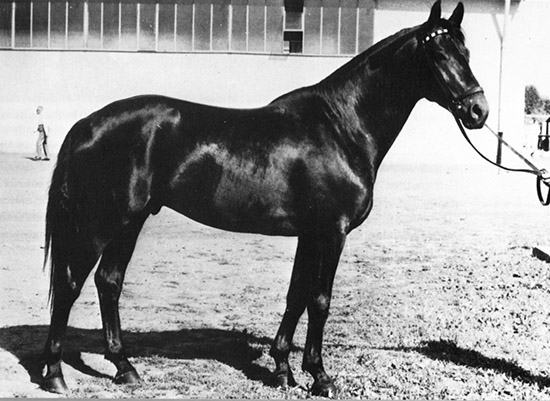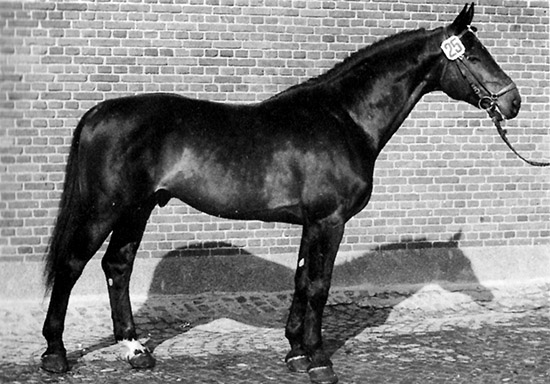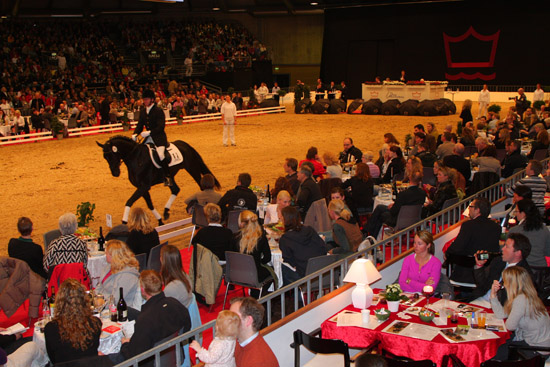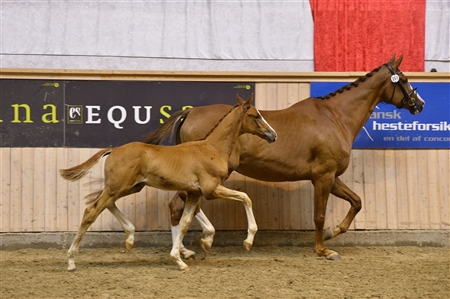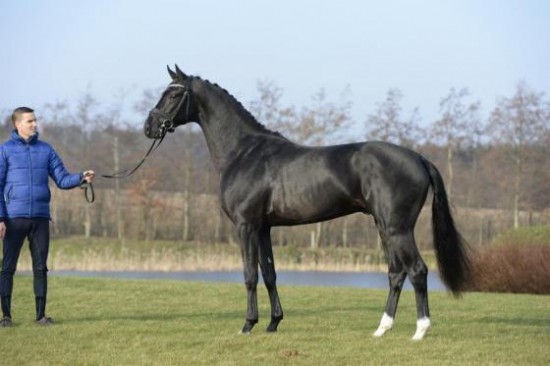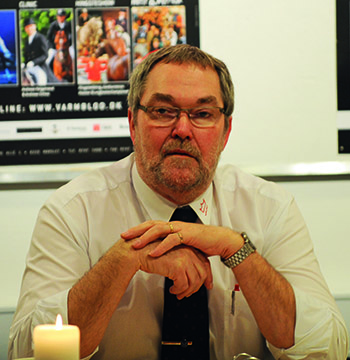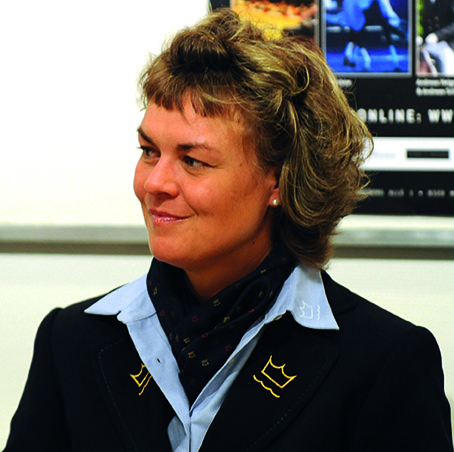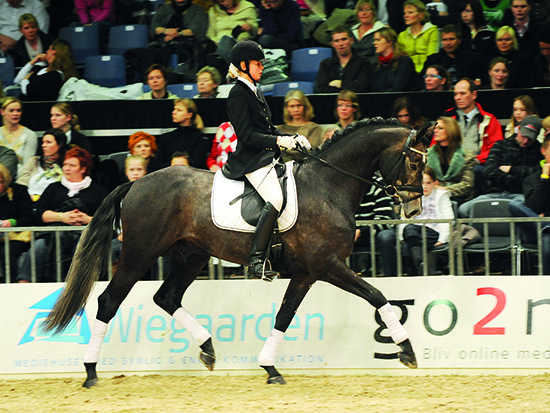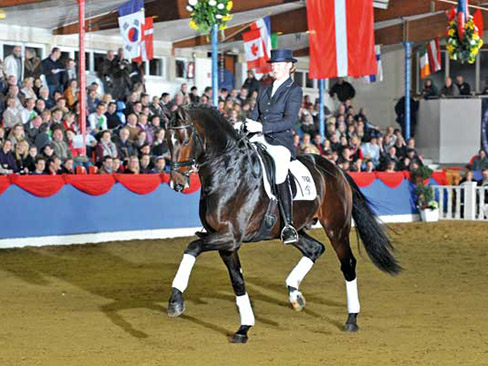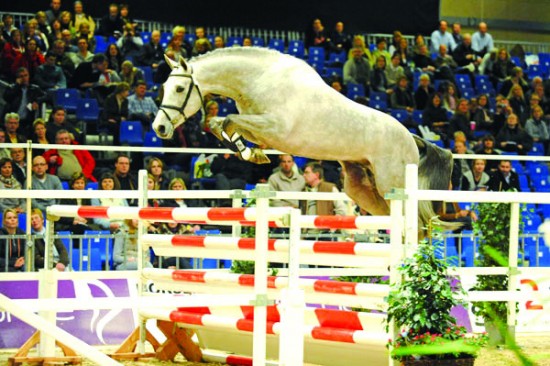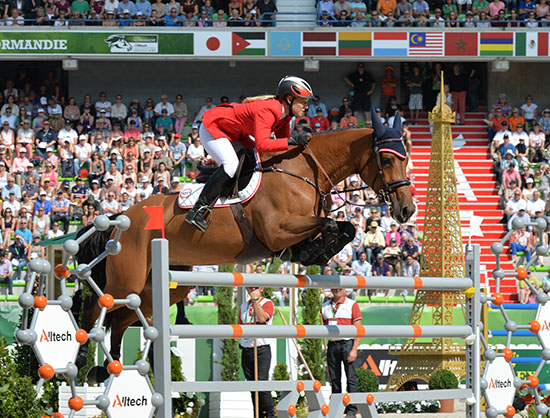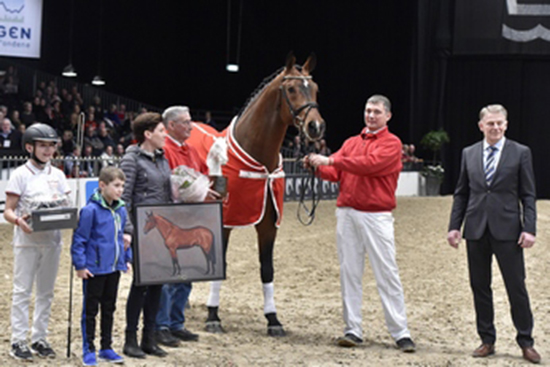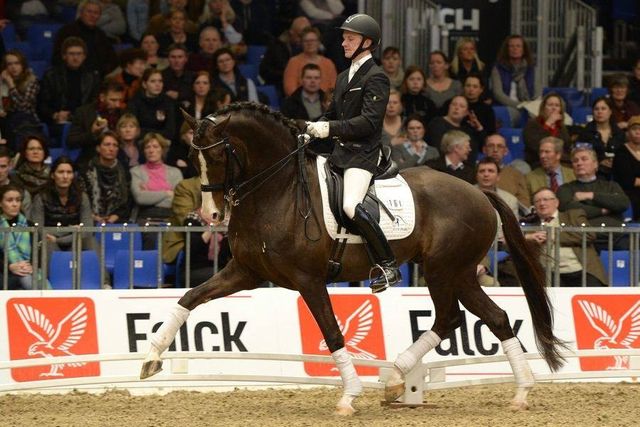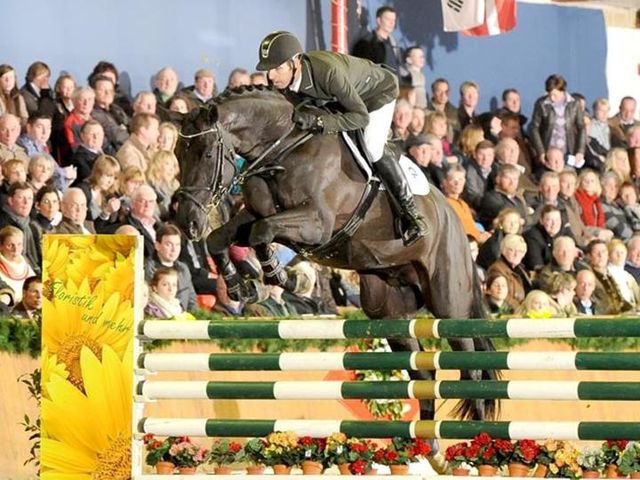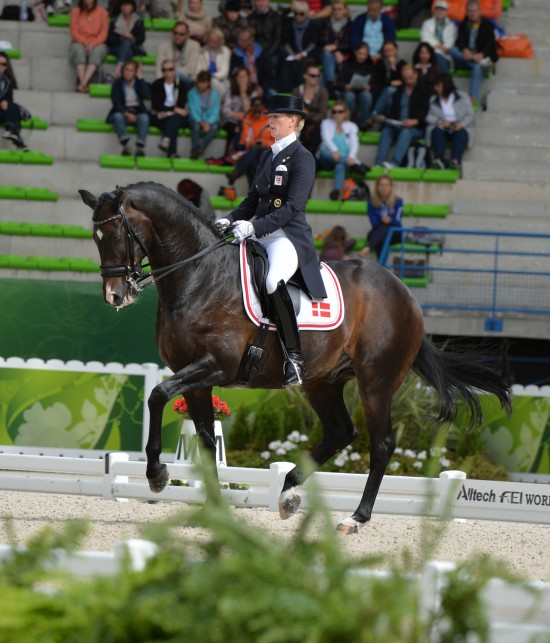
Danish breeding at its best – Danish princess, Natalie zu Sayn-Wittgenstein, riding Digby (Donnerhall / Sandro) bred by Natalie’s mother, Princess Benedikte…
Danish Warmblood breeding is relatively recent, with the establishment of the Dansk Varmbloed Avlsforbund (DVA) in 1962.
Originally there was no Danish riding horse. The two main Danish breeds, the Knappstrupper and the Fredriksborg, were driving horses, and riding horses had to be imported.
The Danes were assisted in putting a breeding policy in place by expert advice from experienced Swedish and German judges. Due to the wide variety of mares in Denmark, the emphasis was on high quality stallions. In the early years the stallions were mainly of Swedish, Trakehner, Hanoverian and Holstein origin, with a few from Poland.
Danish Warmblood breeding grew up in the shadow of their near neighbours, the Swedes, and their policy was closely modelled on the Swedish approach – and highly influenced by Swedish horses. The Danish used the facilities at Flyinge for the first few years of their stallion performance testing, and some 26 Swedish stallions stood in Denmark in the first 25 years of modern Warmblood breeding in that country.
The most influential were Mozart (sire of the stallion, Titian), Herzog (sire of World Champion dressage horse, Marzog), Pilar, Gladiator and the broodmare sire, Epok.
A number of influential broodmares were exported from Sweden to Denmark, including Eliza (Dragos / Fronduer and a half sister to Gaugin de Lully’s sire Chagall) whose son Elizar (by the Trakehner, Unikum) sired the celebrated May Sherif.
Donauwind, was influential in Germany before he went to Denmark and then to the USA. His son, Abdullah was a silver medallist in the showjumping at the LA Games.
Danish stallion owners were prepared to pay for the best and acquired most of the fashionable lines. The Trakehners: Ibikus (Hertilas), Donauwind (Pregel), Herbsturm (Komet), Gunnar (Komet) and Schwarm (Traumgeist xx) had all established themselves in Germany before standing in Denmark. The East Prussian stallions, Gabriel (Gygant) and Ackjonariusz (Sandor) added to the mix, as did the Holsteiners: Alibi (Aldato), and the two Lord sons, Lavallo and Leonardo II, the Cor de la Bryère son, Calimero, the Landgraf son, Lancier, and three sons of Ramiro – Raimondo, Royal Z I and Royal Z II.
From Holstein came Alibi (by Aldato) sire of the international showjumping stallion, Alladin – Alibi is the sire of the great grand dam of Digby…
In the intervening years, the Danes have continued to make good use of the top German bloodlines. The most popular breeding stallion in Denmark for 2007 was Blue Hors Don Romantic. The Don Schufro x Romancier stallion bred to 214 mares in that season. The second most used stallion was De Noir (by De Niro x Matcho AA). He covered 162 mares. The Lauries Crusador xx son, Bogegårdens Laurino was third in the ranking, followed by the Blue Hors Hotline (by Hofrat) and Blue Hors Don Schufro (by Donnerhall).
The most popular show jumping stallion in Denmark for 2007 was Heartbeat (by Heartbreaker) with 119 mares.
The Danes may have been latecomers to the world of Warmblood breeding but they seem determined to make up for it in marketing flair. Their annual Danish Warmblood Stallion Show at Herning, has become one of the major events on the performance horse calendar. The 2009 Show attracted 53,000 enjoying floor space of two hectares. There are a series of huge indoor pavillions with three major competition arenas, lots of warmup and stabling space… there is even an indoor hall where participants can ‘camp’ in their caravans… outdoors would be just a bit too chilly.
At the 2009 licensing, the champion three year old jumping stallion was the Oldenburger, Le Champ Ask (Last Man Standing / Contender). Premium jumping colts were: Akando (A’Khan Z / Quidam de Revel); Tailor Made Count on Me (Cornet Obelensky / Le Vainquer); Tailor Made Stardust (Stakkato / Goodman); Bonaparte Z (Balou de Rouet / Lux Z); Balou Agg (Balou du Rouet / Lacantus); Aggesensgård A/S Cantoblanco (Canto / Carolus I); Canavaros (Cassini I / Contender); Ci Ci Senjor (Cassini I / Contender); Con Cap (Con Air / Corofino I); Tailormade Confidence (Cordalmé / Grannus); Cris (Cristo / Cicero); Cross my Heart (Heart Beat / Caletto I); Aagaardens Heartland (Heart Beat / A’Khan Z); Bøgegårdens Lansini (Landos / Cassini I); Euroman (Embassy / Stakkato).
While the champion dressage stallion was L’Espoir (Lord Loxley / Warkant) jointly owned by Priess Horses and Paul Schockemöhle. Awarded Premiums were: Klepgab’s Don Nido (Blue Hors Don Romantic / Solos Carex); Møgelbjerg’s Don Giovanni (Blue Hors Don Romantic / Walldsohn); Jakas Don Lux (Blue Hors Don Romantic / Lauries Crusador xx); Atterupgaards Fassbinder (Fürst Heinrich / Caprimond); Las Vegas (Loudini / Bøgelys Camaro); Swiss (Sandro Hit / Depardieu); Stevie Wonder (Steddinger / White Star); Gørklintgårds Santos (Sunny-Boy / Carano).
It’s an impressive collection but once again representative of the modern European performance horse rather than anything particularly Danish…
The Champion of the Four Year old jumping stallions was the Danish bred Diamant de Revel (Diamant de Sémilly / Quidam de Revel) – a modern mixture of French with a touch of Dutch, with Nimmerdor in the third generation.
The Champion of the Four Year old dressage horses was Blue Hors Rosoff. He is interestingly bred, being by Blue Hors Romonov out of the Thoroughbred mare, Miss Evergreen xx (by Prince Mab xx).
I can remember being very surprised the first time I went to interview the head of a German State Stud and instead meeting a very large, formidable gentleman in a black bowler, there was a small, attractive woman, Susanne Schmidt-Rimkus, the new director of the Westfalien State Stud. Since then, there is at least one other female German stud director, and even the current crop of male directors tend to a leaner, more modern shape…
Still at the recent Danish Warmblood Licensing and Auction in Herning, I was in for another shock. A carriage came flying into the arena, and out leapt Elisabeth Richard Jensen, who ran as fast as her high heels would let her to the rostrum, where she took up her hammer, and the auction was under-way, with the auctioneer a dramatic stylist, more Carmen than Uwe Heckman. Seemingly this is the only major Performance horse auction in Europe (the world?) with a woman auctioneer.
Elisabeth literally fell into the role, in one of those last minute, twists of fate…
“I had been a speaker… commentator for many International Horse Shows for many years. I’ve been riding ever since I was little and started commentating pretty early. I was commentating at the Summer Elite Mare Show and their usual auctioneer failed to show. They came to me in the morning and said could I just do the presentation of the auction horses. And I said of course, that’s just like another day of commentating. And then an hour before the auction he still didn’t show up and then they came running to me and said, ‘do you have a black dress or something?’ and I said that I had one at the hotel and they said, ‘well go get it, because you have to run the auction.’”
So it was really like one of those Hollywood movies where the star falls sick and the understudy gets the chance?
“Except that I didn’t really study very much for the part…”
Because it’s quite a skill running an auction normally?
“I think that most people would agree that I have become better at it. But I didn’t find it difficult, I found it a little bit unpleasant the first time that I didn’t know the auction horses. Because I usually do spend some time getting to know the horses, getting to know the dam lines and the achievements and performances made on those lines. That is important – not when you do the auction, but when you present the horses at various occasions before the auction. Apparently they were satisfied with what I did because then they asked me if I wanted to continue.”
“As it is right now, I’m doing the Warmblood Auctions for the Main Organisation, and as you perhaps know we have regional organisations, two of them are making their own auctions and one of them I’ve been doing for the past three years and another I’m doing this year also. So right now I’m doing all the Danish Warmblood Auctions.”
At Herning in 2009, Elisabeth was in fine form, pulling a bid of one million Danish Krona (€134,200) for the very first lot: Klebgab’s Don Nido (by Blue Hors Don Romantic), an exceptionally sweet moving three year old stallion. He was sold to a Dutch stallion station, prompting the comment from the Chair of the Auction Committee, Frode Jensen: “It is wonderful that a Danish Bred colt is interesting to a Dutch stallion keeper.”
Despite a global financial crisis in full flight, nine stallions sold for an average of DKK217,778 (€29,225), five riding horses for an average of DKK127,000 (€17,043) and one pony for DKK 120,000 (€16,103).
UPDATE 2014
In 2014, the Danish Warmblood’s auction committee had even more to celebrate after the Elite foal Auction which saw buyers put down a total of 3,860,000 DKK (517,980 EUR/683,100 USD) for the Danish Warmblood foals. 40 out of 49 foals were sold, resulting in a sales percentage of 82 percent. The average price was 96,500 DKK (12,950 EUR/17,080 USD), which is the highest ever average price achieved at the Elite Foal Auction.
Foals were sold to Denmark, Sweden, Norway, the Netherlands, the USA, France and Germany.
The first foal in the ring was the Dressage Colt of the Year 2014, Strandagergaards Sirocco by Sezuan / Blue Hors Don Romantic, bred by Jens Jørgen Abildskov.The foal provoked a bidding war between dressage rider Andreas Helgstrand and an alliance consisting of Kristin Andresen and the stallion station Katrinelund. The latter won.
The price was 550,000 DKK which roughly equals 73,810 EUR or 97.340 USD.
Two foals went for 220,000.- DKK (29,550 EUR/38.810 USD), and both were sold to California. The black filly foal Lipas Adele by Sezuan/ Aljano (bred by Lipas Horses), was purchased by a Dutch agent for a Californian client, and the bay colt foal T-Hawk Axe by Tomahawk/ Blue Hors Zack (bred by Lena og Rasmus Dalsgaard), was purchased by Tomahawk’s American owner Jamie White-Welling.
Three dressage foals were sold for 150,000,- DKK (20.150 EUR/26,460 USD). One of them is Stenagers Falcon by Franziskus/ Wilkens (opdr. Bjarne & May-Britt Christensen) who is a full brother of the most expensive foal at last year’s auction, sold to Anne Lyngby. Her daughter, grand prix rider Helene Melsen, is so fond of this filly that she decided to purchase the brother.
Danish international, Nathalie zu Sayn-Wittgenstein had – amidst all the preparations for and competitions at WEG – also found herself a favourite in the auction collection. The chestnut colt Fredensdals Fifty Cent by Franziskus / Donnerball, bred by Linda Falensteen and Martin Strande, became hers for 150,000 DKK.
When we look at the 2014 stallion licensing, we again see the policy of open borders in action with the Dutch warmblood stallion Galaxy Win T (by Apache x Jazz) proclaimed the champion.
Galaxy Win T – Danish champion, Dutch bred…
Six 3-year old colts were selected for the premium ring – two jumpers and four dressage stallions. The black Galaxy Win T, bred by A. Toonen Arts in The Netherlands and owned by Andreas Helgstrand in partnership with Nico Witte, received the champion sash.
The other three premium dressage colts were the Hanoverian bred Farrell (by Furstenball x Dacaprio), the Danish bred Antobello (by Ampere x Furst Heinrich) and the Danish bred JJ Zinfandel Gronvang (by Zack x Gribaldi).
A total of 22 stallions were approved, 21 3-year-olds and one 4-year-old. The complete list of the 15 dressage approved stallions includes:
– Galaxy Win T (by Apache/ x Jazz) – Breeder: A.M.T. Toonen Arts – Owner: Helgstrand Dressage & Stall Witte
– Farrell (by Fürstenball x Dacaprio) – Breeder: Hans-Heinrich Plate – Owner: Blue Hors
– Antobello (by Ampere x Heinrich) – Breeder: Anne og Allan Sørensen – Owner: Stutteri Højagergaard
– JJ Zinfandel Grønvang (by Zack x Gribaldi) – Breeder: Vicky & Annette Lauridsen – Owner: JJ Horses
– Bøgegårdens Alphabeat (by Ampere x Don Schufro) – Breeder: Hermann Meyer – Owner: Stina & Jørgen Schmidt
– Nymphenburgs First Ampere (by Ampere x Weltruhm) – Breeder: Jan Siemsglüss – Owner: Stutteri Volstrup & Gestüt Nymphenburg, Tyskland
– Giovanni BM (by Apache x Belisar) – Breeder: J.P. Mom og W. Bossewinkel – Owner: Blue Hors
– Dragon Hill (by Damon Hill x Sandro Hit) – Breeder: Sandra Grede – Owner: Lone Bøegh Henriksen – Paul Schockemöhle
– Don Deluxe (by De Niro x Rosario) – Breeder: Josef Greten – Owner: Helgstrand Dressage
– Dice (by Desperados x Lanthan) – Breeder: Günther Vorwerk, – Owner: Kristin Andresen og Ib Kirk
– Freestyle (by Fürstenball x Don Romantic) – Breeder: Wilhelm Schwierking – Owner: Ib Kirk
– St. Schufro (by St. Moritz Junior x Don Schufro) – Breeder: Joachim Wahlers – Owner: Blue Hors
– Ellely’s Tornado (by Temptation x Flemmingh) – Breeder: Birgith Thomasen – Owner: Steffen Kristensen
– Blåhøj’s Zagato (by Zack x Solos Landtinus) – Breeder: Maj-Britt & Jens Gøbel – Owner: Blue Hors
Goldfinger V.D.T. (by Jazz x Ferro) – Breeder: A. van de Tillaart – Owner: Helgstrand Dressage & Ad Valk
Of the 15 licensed dressage stallions, three are owned by Andreas Helgstrand and four by Blue Hors stud.
Breeding Values 2013
Heading the standings for Dressage Stallions we find Sandro Hit with a value of 156, closely shadowed by his old sparring partner, Jazz on 154. Ten points behind in third is the tend years old Skovens Rafael who combines the blood of two of the Blue Hors stallions – he is by Romanov out of a Don Schufro mare, out of a mare by the Grosso Z son, Zorro Z, out of a mare by May Sherif. Equal third is Blue Hors Hertug, an 18 year old Trakehner, by Schwadroneur out of a Donauwind mare. Fifth is the ten year old Blue Hors Zack (Rousseau / Jazz) on 140, equal with Don Schufro (Donnerhall / Pik Bube). Then comes Hotline (Hofrat / De Niro) and Gribaldi (Kostolany / Ibikus) on 138, Blue Hors Don Romantic (Don Schufro / Romancier) and rounding out the top ten, the Trakehner, Schwadroneur (Arogno / Ibikus) with a value of 136. Schwadroneur who was born in 1983, died back in 2003.
The jumping ranking is headed by Bøgegårdens Apollo on a score of 149. The stallion is by Acord II out of a mare by Ronald, and he had a moderate international career with Emile Martinsen, the pair placed 51st at the 2011 Europeans in Madrid. While he has only two progeny listed with international results, one of them, the mare, Appollonia won the 2014 Grand Prix at Arezzo***, and the pair placed 20th at the WEG in Caen. Second to Casino on 144 who is by Capitol out of a Caletto II mare. The stallion was born in 1992, and has spent the 2012/13 seasons back in his native Holstein. Ridden by Michael Aabo, Casino had a very modest international career, they attended two European championships for 44th in 2005 and 57th in 2003. On 143 we have Heartbeat, born in 2009 and by Heartbreaker out of a Ramiro mare. The stallion was crowned Danish Stallion of the Year in 2013, but his performance record is modest – just two international appearances in 2014 for a 6th in a 5 year old class at Ebreichsdorf, and 8th in a 5/6 year old class at Lamprechtshausen. Fourth, Rockland (Rockwell / Landino) 141; fifth – Corland (Cor de la Bryère / Landgraf) Here we have a genuine international star, also known as Corland, this stallion was 9th at the 2001 Europeans, and had a distinguished career with Wout-Jan van der Schans. Breeding value – 139. Sixth, Cajus (Coronado / Lagano) 138; Equal Seventh, Casir Ask (Cor de la Bryère / Landgraf) and Lagano (Leander / Roman) on 138; 9th, Carano (Capitol / Cor de la Bryère); 10th, Corratus (Corrado / Cantus) 135.
Most used stallions…
As usual, the breeding values rankings and the most popular stallion list are not all that similar. Blue Horse Zack with 205 mares was the most popular stallion in 2013 followed by his son, Sezuan (out of a Don Schufro mare) with 169. Tailor Made Attention covered 143 – this four year old stallion is by the Alabaster son, Abanos, out of a mare by the Carpaccio son, Bøgelys Cannaro. The reason for Attention’s popularity is a little difficult to fathom, he was dressage foal of the year in 2008, was second in the four year old Danish championships, and the sire of the dressage colt foal of the year 2012. Blue Hors Zatchmo had a book of 124, he is by Zack and out of a Donnerhall / Pik Bube mare, who is the full sister to Don Schufro. So far the stallion’s claim to fame is that he was a finalist at the Danish Championships in 2013 and was a favourite of the crowd at the licensing! Fifth with 119 mares is Blue Hors Don Olymbrio – by Jazz out of a Ferro mare – this young stallion qualified for the Danish Four Year old championships… Sixth to Sir Donnerhall II (Sandro Hit / Donnerhall) with 75 mares. This stallion has had a fairly controversial career – he was leased by the State Stud at Celle but after he had covered quite a few mares, he was rejected by the Hanoverian Licensing commission in 2010, and the Hanoverian mare owners found they had to register their foals with Oldenburg – where Sir Donnerhall II was the sire of three approved stallions in his first year. Sir Donnerhall went on to win a bronze medal at the World Young Horse Championships in Verden, where he had been shunned by the commission. Seventh, De L’Or (Dancier / Rotspon), another young stallion (born 2009) with 59 mares. Eighth, Blue Hors Rockefeller, a full brother to Romanov (Rohdiamant / Grundstein II), with 52; Blue Hors First Choice (born 2010, by Jazz out of a Negro mare) 48 and tenth, Zodiac (Zack / De Noir) with 44. Just out of the top ten is the top jumping sire, Favorit Ask with 41 mares. The stars of yesteryear have certainly fallen from favour, with just 21 mares for Don Schufro and 11 mares for Don Romantic.
An interview with Jan Pedersen
To find out more about the Danish Warmblood, who better to ask than Jan Pedersen, who is not only the head of the Danish Warmblood Association, but also the President of the World Breeding Federation for Sport Horses. I caught up with him at the Danish Licensing in Herning in March 2009:
Putting on your Danish hat… how did the show at Herning develop?
“It started in a small way, thirty years ago, and we have tried to develop the show every year. It really has grown a little bit bigger, and a little bit better, every year. Twenty years ago, the horses were stabled 500 metres away in un-heated stables, but at that time, it was okay. Now everything is in the warmed up halls. In Germany when they trot the stallions out on the hard surface, they go outside to find some asphalt – we can even do that inside because we build an asphalt strip… ten years ago, we had to go outside. Year by year, this event gets a little bit better. We try to learn from our experiences…”
What do you see as the strength of the Danish Warmblood?
“The strength is that we have an open policy, that we try to attract the best horses from all over Europe. At this show, you can find the best showjumping stallion from Oldenburg, the winner from Holstein, they are all here – and I think this open policy will take us to a leading position. We never say our horses are the best in the world, we really try to keep an open mind – and this open policy is our strength.”
Is there a worry, that what might have been historically, and distinctively, Danish is being submerged under all this other blood?
“Of course, yes some people are afraid of that. But we have other organizations in Denmark trying to keep the original horses and they do a good job. But we try to produce the best dressage horses, the best showjumping horses, and to be able to compete, we need to bring in the best all the time. In Denmark we are not big enough to be ourselves only.”
You have very strongly split between dressage and showjumping stallions…
“That is also very new. Five, six years ago we didn’t do that, but we know that it takes different skills to jump well and to compete in dressage: showjumpers and dressage horses are very different.”
Yet, certainly in Hanover, there seems to be a re-thinking on this subject. Some years back, it was considered very old fashioned to want all the stallions to jump at least a little but now I get the impression that they are looking to certain jumping blood to keep the movement in their dressage horses… If we look at the horses that won the World Breeding Dressage Championship for Hanover, really only Warum Nicht is bred for dressage, the others are bred to jump… Even the Danish dressage horses that are going well now in dressage, many of them are jumping bred?
“In the breeding of dressage horses, it is a good thing to mix some good showjumpers from time to time, but with showjumping horses, you will never find dressage blood. The showjumpers have something we can use in the dressage horse, but not the other way round.”
Does that create a problem, everyone wants to breed to this year’s licensing winner, and other blood gets no chance?
“That is a little bit of a problem that the new stallions are popular and everyone wants to use them. In Denmark, I think our system is good because the young stallions after they are licensed, they go directly to a test, it is only ten days but they are tested under the rider to see if they are rideable, to see if they have got a good character, we know something about the horses before they start their breeding career. I talked to the breeding advisor in Oldenburg, and he told me that the biggest problem in Oldenburg, was that everyone seems to use the young stallions, and they really don’t know anything about them. I think we know a little bit about them. Also our licensing is half a year later, so I think the basis is better because the horses are older.”
“Still it is a problem. It is important that the young stallions cover a certain number of mares, but not 300… Years ago we had a system trying to regulate that, but it is almost impossible.”
Yet, history probably shows us more famous stallions that failed their licensing than famous stallions that won their licensing…
“I think today we know a lot more about the stallions than they did then, because we have these breeding values and they give a good picture of what that horse is made up of, of what is in the horse. Earlier, you had only the performance test and the way the horse moved, today we know more. I don’t think we have that problem any more…”
Are your breeders very influenced, by the breeding values?
“In Denmark there is a very strong relationship between breeding values and the number of mares – if they don’t have a good breeding value, then they don’t get any mares.”
How many mares would a stallion in Denmark get in a season?
“Some stallions cover about 250 / 300 mares, and that is the top. We have a few that also cover mares abroad, so they may have 500 or 600 mares.”
Where do you see the shape, the look, of your horses going in the future?
“I think the horses will be more uniform, there is a tendency for very few stallions to cover all the mares. I think in five or ten years, these breeding values will be even better and really tell you the absolute truth – and when we have those, and when we get to the point where we can compare breeding values across the borders, then it will be easy to tell where are the ten / twenty best stallions and everybody will use them, and it will lead to a uniform horse, I think.”
In Germany there are two sorts of breeding values – the FN values and the Hanoverian values, the Hanoverian ones are based more on the progeny and less on the performance of the stallion himself, which way do your breeding values lean?
“Our system is more like the Hanoverian system.”
More on mare tests?
“Yes, because there is not so much environment when you do it like that, the influence of the rider is not so big.”
To move to your other role as the President of the World Breeding Federation, in what kind of shape is the WBFSH right now?
“I think it is in a good shape. Only a few years ago we looked at each other more as competitors, rather than partners, and today I think that has changed a bit. We are still competitors but we are not afraid of each other any more, so there is a very good atmosphere – although you have to be very careful because the various studbooks don’t want us to interfere, and that’s not our job to do that. Sometimes it can be a different balance. For instance, we had this project, called Inter-Stallion, a project about comparing breeding values across the borders. We had big discussions on that because the Germans and the Dutch did not want us to continue with that – they had no interest in the project, they did not want things to get too transparent I think.”
Too transparent or too muddy? It seems to me if you try to compare say across borders you run into real problems. You could have a stallion in Australia producing horses that win at Grand Prix dressage and on the basis of those results, his breeding values would put him in the top 4% internationally, and yet, the progeny of that stallion, taken to Germany where the standard of competition is much higher, would never ever place in Grand Prix competition…
“But that is exactly what this project is about, that you can compare across borders…”
But how can you compare when the standard of competition is so different, where the height of the fences in a Grand Prix showjumping are so different…
“That’s technique… That’s exactly what it is all about to compare, even though the basics are very very different. Right now you can’t do that because your standards are different. That’s what it is all about, to be able to compare how much better is the German horse than the Australian horse.”
But if you breed a stallion in Australia that breeds five World Cup winners but the progeny are doing them over little, easy tracks – how do you compare that with the progeny of a stallion in Germany, where to win a World Cup they have to jump a much tougher track, and against much tougher competition?
“It’s a very complex problem and we have scientists working on that, geneticists working on that, trying to find a way to compare and take all these things in consideration, when you compare the breeding values. When we started this we were inspired by Inter-Bull, they have this system in cattle breeding and it really has had a great influence on the development of cattle breeding.”
But a gallon of milk in Australia is the same as a gallon of milk in Denmark…
“Yes, that is true, it’s much easier to compare cows than mares, that’s true. Still the scientists working on it feel that it is really possible and they have come a long way, because the project has not stopped. Some of the members of the World Breeding Federation wanted out, and now only Ireland, Denmark, Sweden, Belgium, France, are still in the project.”
Integral to the whole concept of the World Breeding Federation from the start has been this concept of the competition between the studbooks, and this has been one of the defining moments each year – which studbook is the winner. I wonder how meaningful that has become… after Hong Kong, I think it was Xavier Libbrecht in ‘Breeding News’, who wrote, ‘oh what a disaster for the Holsteiners, they scarcely won a medal’ but if we look behind the brand, to the blood…
“There is much Holsteiner blood…”
All the horses that were winning medals in showjumping, were Holsteiner blood, some were even born in Holstein and re-branded in the next country – has it all become a little meaningless?
“I don’t think so, it is not so much a question of race any more, it is more a question of how good are the breeders of that specific stud book. It is true that the Holsteiner Verband was not so successful in Hong Kong, but the horses were, so what you are getting at, is that we got the wrong impression. Of course, when things open up, the way they have in recent years, then things may get a little bit blurred.”
You say – oh, it is what the breeders set out to do that is important, their skill as breeders, but the guy who bred Salinero never thought he was breeding a dressage horse, he thought he was breeding a showjumper. Is it more like the theory of Jörg Savelsberg, the breeding expert on Horse International, it’s just a matter of luck?
“It is also a question of luck, but not entirely. It is a question also of luck in that it is a question of finding the right horse / rider combination, the right education for the horse, there are so many factors involved in top class performance.”
That also makes the project of comparing across borders very difficult – in a country like Germany, there are a couple of hundred top trainers, but in a country like Australia, less than ten, and that situation makes it much more the case of which horses goes to the good trainer than which was the better bred horse in the first place… A good trainer can make the reputation of a poor stallion…
“These rankings from a breeding point of view, are not too interesting, we must say that, they are more a tool of public relations. The size of the stud books are so different. In Denmark we produce 3000 foals a year, in Holland they produce 15,000 foals. So of course it is difficult to compare because they have much more volume than we do. That is exactly why we go to the Hanoverian system for our breeding values, because when you look only at the top class performers, then too many things are involved: the rider, the upbringing, the education, and that has nothing to do with breeding.”
And yet, if I read it correctly from the last World Breeding Federation Congress, it looks very much as if the stallion rankings were going to be on the basis of the best six progeny, and not on the basis of all the progeny competing in international competition?
“It’s not going to change…”
But it has changed about three times. Originally there was a formula that was very heavily weighted in favour of top competition – any stallion that had a horse win a gold medal at an Olympics, was immediately the world’s best stallion, even if that was the only horse that stallion produced. Then it all disappeared, and Jörg Savelsburg just kept going on his own, using the figures from the FEI results for the year, with no weightings, and published those stallion rankings in Horse International, and now – if I read it rightly – the rankings were going to be done by the KWPN but on the basis of the top four progeny?
“No, it will be all the progeny in competition for the year. They just add all the results of the offspring of each stallion.”
At Herning last year, there was discussion of a single Scandinavian stud book? And it was suggested that could be the second highest ranking dressage stud book in the world – has this progressed?
“In Scandinavia, we have the Norwegian stud book, the Finnish stud book, the Swedish and the Danish, and we are getting together. If we merged to one stud book, then we would be second in the ranking in dressage. That was just an experiment, because we are not going to merge. We work closely together, but I think we will never be one stud book, it was just a brain storm.”
What do you see as the major challenges for the World Breeding Federation?
“I think it is very important to focus on the close connection between breeding and sport, and to have this very close cooperation with the FEI, that’s very important. Earlier that was not there at all, the riders had no interest in breeding, they did not know about pedigrees, today this has changed totally and I think it has some thing to do with our efforts. Also for the FEI because only a few years ago, the FEI was not interested in breeding at all, and that has changed. I think if we work together, we can get to a higher level together.”
Talking with the Danish licensing commission…
At the Herning show, there was also the opportunity to quiz two of the members of the licensing panel – Poul Graugard, who has been a member of the commission since 1986 and who acts as the commentator, and Katrina Christiansen, breeding advisor with the Danish Warmblood Association.
Mr Graugard explained how the young stallions were divided into dressage and jumping streams, to the extent that now the ‘dressage’ stallions are not required to jump at all at the licensing…
“We see all the young stallions jump at the pre-selection, and then we make a decision, which way they have to go if it is not a clear pedigree for dressage or jumping.”
The commission makes the decision, not the owner of the horse…
“Yes, therefore you can see dressage stallions with a lot of jumping blood in their pedigree because they are moving better than they are jumping. I am very happy with the selection this year because I think we have much more information on the horses as a result of the way we did it this year, than earlier years.”
The commentator said that the commission was looking for a different sort of canter and different conformation for the jumping horses can you discuss this?
This time Karina Christiansen took the question:
“Yes, I think in the future we’ll see a difference in the conformation between dressage horses and showjumpers. I think for a dressage it is very important that he is built to move uphill, so no short front legs, and it is important that the neck is built uphill. It is important that the canter for the dressage horses is also uphill, because eventually they will have to do pirouettes… but for the showjumper, it is a little bit different, it is more important to have a horizontal conformation. The neck should not be as uphill for the jumpers – because it is important for the horse to be able to stretch over the jump, and that is very difficult if the neck is built too much uphill like the dressage horses. Also if you are doing a showjumping round on time, it is very difficult if the canter is very much uphill because you are losing a few seconds every time, the showjumpers have to move fast and straight, they have to do more horizontal, that is the main difference.”
Poul made the added comment: “For the jumping horses we only concentrate on the canter. When you have a showjumping pedigree, and a very good jumper, and a good well balanced canter, that is enough. When you have the dressage horses, we want three really good gaits. The difference is the jumping ability and the gaits, and more and more, how they are built in the body.”
And Katrina added: “At the licensing, the showjumpers will not get any marks for the walk and trot, but when they come to the performance test, the stallion owner can choose, whether they put the stallion forward for testing in dressage or jumping, or both. So if the stallion has very good movement, he can be tested in both, it’s up to the stallion owner, but I think most of the stallions in the future, will also be specialised in the test, very few will do both.”
There has been a lot of controversy about how young horses have been shown, and it has been suggested that the three and four year olds should be shown in a more natural, relaxed way – is this a problem in Denmark also, too much pressure, too much tension in the young stallions?
Katrina did not see this as a big issue for Denmark: “Not really because it is a little bit different in our performance tests from what you have in Germany. After the licensing, we have the ten day observation tests, and the stallions will not get any marks. This observation test is just to test the temperament, if they have any stereotypies that we cannot accept, or if they have a very bad temperament and cannot be ridden at all. If they are alright, then they get a covering license for one year. Then we have the performance test in the autumn, and that is only for 35 days, not 70 days as in Germany. So I think in Denmark we’ve tried to get an easier system, not to press the young stallions too much – not to do a 70 day test. I think it is okay in Denmark.”
I didn’t mean the stress of the performance test – more the way they are presented in Young Horse classes, and at shows like this…
Once again, Poul felt Denmark was on the right way: “It is not a real problem in Denmark, I think the Danish stallion owners are not like the stallion owners in Germany and Holland. I have myself seen three year old horses in those countries going like six or seven year old horses, and we don’t like that, and our stallion owners don’t like that.”
Tailor Made Lancelot
This four year old stallion was one of the stars of the 2009 Warmblood Show in Herning, starring in the dressage section despite a pedigree that says – jump, jump, jump. His sire is the Holsteiner, Lordanos (by Landos by Lord, out of a mare by Ahorn Z, out of a mare by Calypso I. Lancelot’s dam Ginastera is a Hanoverian, by Ginsberg ( by Graf Grannus out of a Matcho mare) out of Dakota by Dynamo by Don Carlos)
“Maybe you saw Tailor Made Lancelot, he is maybe the best dressage horse of them all, and it’s an absolutely marvellous like that, when they go like that.”
He has a jumping pedigree, can he jump as well?
“No, not at all. When we saw him in Oldenburg last year, he jumped really well, and we also looked at his three good gaits, but when he went to the 35 day test he was much better in his dressage ability – he was not good enough in the jumping.”
Where are the dressage bloodlines going – there is a lot of ‘D’ blood in Denmark, and some ‘S’, what would you like to add to deal with all the ‘D’ line?
“I think also the Flemmingh bloodline from Holland is also very good with the D line. Dressage horses in Europe are mostly from four stallion lines, Rubinstein, Donnerhall, Weltmeyer, Sandro Hit, and it is necessary to look for something else. Blue Hors Zack for example is very good in connection with D blood, his oldest offspring are yearlings, and they are absolutely good. We saw them in the young horses classes, and they were light in type, really nice neck, good looking eyes, and very good gaits.”
Blue Hors Zack – the cross with the D line?
“We are still looking around the world for bloodlines we can use in the future… right now we are in a very good position because we have stallion owners prepared to pay whatever it costs to get top stallions.”
You have very good jumping stallions, is it hard to get the mare owners to send their mares to a jumping stallion?
“In Denmark, maybe 80% of the breeders are breeding dressage horses, and 20% jumping horses – normally the dressage horse breeders don’t want to use jumping stallions, but a stallion like Lancelot, I think will be used a lot for dressage breeding.”
Karina pointed to the success of the Danish jumping program: “A few years ago we started the showjumping program, like they have in the Hanoverian Society, and the main aim of that was to get the mare owners to use the jumping stallions on their jumping mares, not to go and cover jumping mares with a dressage stallion, and I think the showjumping program is getting more and more popular, at the shows we are doing a lot of advertising in the programs, and it is now a kind of prestige to get into the program, and that is good.”
Poul pointed to the influx of top stallions: “In the last few years, we have seen the emergence of new jumping stallion owners, and they are buying the good jumping stallions from all the top stud books. They bring them to us, and we approve them if they are good enough, but really we don’t need so many jumping stallions, we need more dressage stallions.”
Licensed at Herning, Le Champ Ask (Last Man Standing / Contender) owned by the Danish Stallion Station, Stutteri Ask – the jumping division of the Blue Hors Stud. The colt earned two 10s for jumping technique and capacity. Bred in Oldenburg, he was the Champion of the Springferdezucht-Verbandes Oldenburg International (OS) and then sold for €1.1 million. His sire is the relatively obscure Last Man Standing (by the Landgraf grandson, Lovari out of a daughter of Landgraf) out of Mordela, a daughter of Contender out of a mare by the Ladykiller son, Lorenz. The stallion line up in the fourth line of Le Champ Ask’s pedigree is something of a history of Holstein breeding and indication yet again, how close those Holstein breeders are prepared to bred: Landgraf, Captiol, Ladykiller, Waterman, Cor de la Bryère, Ramiro, Ladykiller, Cor de la Bryère.
Alas not long after, it was discovered that the young ‘stallion’ was infertile!
Is it a problem with breeders breeding to the young stallions and ignoring the older stallions – the ‘fashion’ breeders?
Karina agreed: “Yes, I think it is a problem all over the world. It is difficult to see a solution. You can help the breeders a lot, in Denmark we have a special offer of advice – the mare owners can call the breeding committee and ask which kind of stallion they should use for this mare, and a lot of people are doing that. I think the breeding committee is trying to convince them about sometimes using older stallions, but I think it is a universal problem that mare owners don’t know so much – they see a nice picture and they want to breed to the stallion.”
“We have a lot of breeding courses around the country, where the breeding committee is telling about the different bloodlines, about the different stallions, and giving advice, we are trying to help the mare owners to make a good decision.”
Is there any promotion of the mare lines?
According to Poul: “The mare line is 70% of the result. Our mare lines were in the past mixed bloodlines, because they were coming from different stud books, but now I think we have stronger and stronger mare lines, especially for breeding dressage horses, but I think in the next few years, the good bloodlines for breeding jumpers will come. It is specially a problem when the breeders use the young stallions with the young mares, they don’t know anything about the breeding, and there are a lot of people doing that. If you use a brand new young stallion with a mare line that you know for generations, that is not such a big problem, but there are not so many breeders with mare lines like that…”
Are you testing more for the temperament of the stallions nowadays?
Karina thought it was a great idea, but how? “Actually no, but we would like to do so. We haven’t really found a test to do that, but we would like to. Still I think we are doing a lot because in the performance test, we are giving marks for temperament, and on the mare’s side, all the mares under the rider are given a mark for rideability. We are doing something on the temperament side, but we would like to do a lot more, we just don’t know how to test for temperament in an objective way.”
Stallion of the Year 2015
Bøgegårdens Apollo is a 17-year-old Holsteiner stallion by Acord II/Ronald. He was purchased as a 2-year-old colt at his breeders on the German island of Föhr by Theodor Schmidt, the founder of the Danish stallion station Bøgegården which is now run by his son Jørgen Schmidt. Apollo is still stationed at Bøgegården but owned by the internationally successful Danish show jumper Emilie Martinsen who competed the stallion at the Europeans in Madrid in 2011.
One of the successful offspring by Bøgegårdens Apollo is the mare Bøgegårdens Apollonia (dam sire Bøgegårdens Capello) which landed an individual 20th place at the World Equestrian Games in Caen last year, ridden by 22-year-old Stefanie Bistan.
“Now that Bøgegårdens Apollo has come home to enjoy his retirement we hope the breeders will use him for their mares. The quality of his offspring is indisputable,” said spokesman of the licensing committee Poul Graugaard.
Bøgegårdens Apollo and the Schmidt family
2015 Licensing – the best ever?
The licensing committee at the 2015 licensing in Herning selected nine 3-year-old colts as premium stallions. Three of them bred for jumping and six of them from the collection of dressage bred colts.
Spokesman of the licensing committee, Poul Graugaard, praised the collection as the best collection in many years – “probably the best collection ever.”
Twenty three 3-year-olds and two 4-year-olds made up the collection of 25 young stallions approved for the 10-day test prior to receiving their full breeding license for this season.
Out of the 25 colts, 16 were bred for dressage and 9 for jumping. 6 dressage prospects and 3 jumping prospects were selected as premium stallions. 9 out of the 16 dressage colts are Danish bred (56,25%), and 7 out of the 9 jumpers are Danish bred (77,78%).
Premium dressage stallions
Hesselhøj Donkey Boy by ERA Dancing Hit/Milan
UNO Don Olympic by Blue Hors Don Olymbrio/Del Piero
Dreamline Kilen by Blue Hors Don Olymbrio/Blue Hors Hotline
Foxtrot by Foundation/Fürst Heinrich
Salut Halsnæs by Tailormade Temptation/De Noir
Blue Hors Zalabaster by Blue Hors Zack/Alabaster
The dressage stallion with the most Premium colts was the seven year old Blue Hors Don Olymbrio, a solidly Dutch bred stallion, by Jazz out of a Ferro mare, out of a Sultan / Doruto mare.
Blue Hors Don Olymbrio
Premium jumping stallions
Aagaardens Chico Ask by Favorit Ask/Chico’s Boy
Bøgegårdens Gladiola by Bøgegårdens Graf’s Stakkato/Bøgegårdens Apollo
Quintet by Quintender/Stakkato
Easily the most successful jumping stallion was Favorit Ask. The Belgian bred stallion is by Diamant de Semilly out of a Darco / Quidam de Revel mare. He was the sire of one premium stallion, and three approved stallions.
Approved dressage stallions
ERA Dark Legend by Dancier/Sandro Hit
D’Avie by Don Juan de Hus/Londonderry
Happy Feet by Blue Hors Don Schufro/Jazz
Feel Good by Fürstenball/Friedensfürst
Romador Elton by Blue Hors Romanov/Matador
Blue Hors Zirrus by Blue Hors Zack/Donnerhall
Katrinelund Tin Tin by Tailormade Attention/Cavalier
Spartacus by Sporcken/Weltmeyer
Alt For Damerne Firfod by Sunny-Boy/Zalmiak Firfod
Zoulmate by Blue Hors Zack/Donnerhall
Approved jumping stallions
Cor de Ask by Ci Ci Senjor Ask/Lambrusco Ask
Diablo by Diamant de Revel/A’Khan Z
Kløvergårds Dirty Dancer by Favorit Ask/Lambrusco Ask
Frodo Ask by Favorit Ask/Coronado
Highland Park by Favorit Ask/Stakkato Gold
Nomanee by Nonstop W/Carthago
(This report originally appeared in 2009 – updated 2015.)



